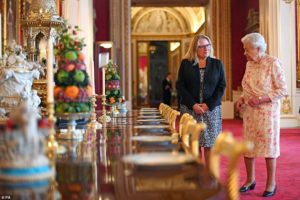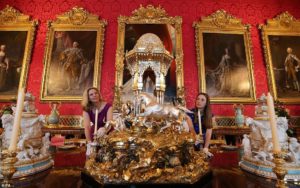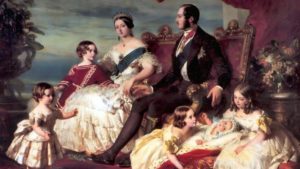The Sunday Times: With one magnificent renovation, Queen Victoria revamped the monarchy
A new exhibition reveals how the monarch’s redesign of Buckingham Palace created a home for her family and a focus for the nation, writes its co‑curator, Amanda Foreman.
Did Queen Victoria reign over Britain or did she rule? The difference may seem like splitting hairs, but the two words go to the heart of modern debates about the way society perceives women in power. A sovereign can be chained in a dungeon and still reign, but there’s no mistaking the action implied in the verb “to rule”. The very word has a potency to it that the mealy-mouthed “reign” does not.

The Victorians could never quite resolve in their minds whether Victoria was ruling or reigning over them. To mark her diamond jubilee in 1897, the poet laureate, Alfred Austin, composed Victoria, an embarrassing poem that attempted to have it both ways — praising the monarch for 60 dutiful years on the throne while dismissing her: “But, being a woman only, I can be / Not great, but good . . . Nor in the discords that distract a Realm / Be seen or heard.”
Despite a wealth of new scholarship and biographies about Victoria, most people still find it hard to say what she actually achieved, aside from reigning for a really long time. It’s as though she simply floated through life in her womanly way, pausing only to fall in love, have babies and reportedly say things such as “We are not amused”. Her personal accomplishments are diminished, ascribed to Prince Albert’s genius or ignored.
I have co-curated, with Lucy Peter of the Royal Collection Trust, an exhibition for this year’s Buckingham Palace summer opening. It is an attempt to redress the balance. Queen Victoria’s Palace argues that Victoria’s building programme at Buckingham Palace helped to redefine the monarchy for the modern age.
The new design enabled a more open, welcoming and inclusive relationship to develop between the royal family and the public.
The house Victoria inherited in 1837 was nothing like the building we know today. The Queen’s House, as Buckingham Palace was then known, was a mishmash of rooms and styles from three reigns.
 The entertaining rooms and public spaces were too small, the kitchens dilapidated, the private apartments inadequate and the plumbing and heating barely functional.
The entertaining rooms and public spaces were too small, the kitchens dilapidated, the private apartments inadequate and the plumbing and heating barely functional.
Victoria, and then Albert after their marriage, put up with its failings until there was no room for their growing family.
It’s certainly true that Albert was more involved than Victoria in the decoration of the interior. But it was Victoria’s conception of female power that dictated the palace’s final form. Kingship, as Austin’s jubilee poem helpfully pointed out, is expressed by such manly virtues as strength, glory and military might, none of which Victoria could claim without appearing to betray her feminine identity.
Instead she made queenship a reflection of her own moral values, placing the emphasis on family, duty, patriotism and public service. These four “female” virtues formed the pillars not only of her reign but of every one that followed.
Today it would be impossible to conceive of the monarchy in any other way. It is one of the very few instances where gendered power has worked in favour of women.
The Buckingham Palace that emerged from its scaffolding in 1855 was a triumph. The additions included a nursery for the children, a large balcony on the east front, state rooms for diplomatic visits and a ballroom that was large enough to accommodate 2,000 guests.
For the next six years the palace was the epicentre of the monarchy. The death of Albert on December 14, 1861, brought a sudden and abrupt end to its glory.
Incapacitated by grief, Victoria hid herself away, much to the consternation of her family and subjects.
The story of Victoria’s eventual return to public life is reflected in the slow but sure rejuvenation of the palace. There were some things that she could never bear to do there, because they intruded too much on personal memories: she never again attended a concert at the palace or played host to a visiting head of state or gave a ball like the magnificent ones of old.
But Victoria developed other ways of opening the palace to the wider world. One of the most visible was the summer garden party, a tradition that now brings 30,000 people to the palace every year.
 She also allowed Prince George — later George V — and Princess Mary to appear on the balcony after their wedding, cementing a tradition now watched by hundreds of millions. The palace balcony appearance has become so ingrained in the national consciousness that each occasion receives the most intense scrutiny.
She also allowed Prince George — later George V — and Princess Mary to appear on the balcony after their wedding, cementing a tradition now watched by hundreds of millions. The palace balcony appearance has become so ingrained in the national consciousness that each occasion receives the most intense scrutiny.
At last month’s trooping the colour, lip-readers were brought in by media outlets to decipher the exchange between the Duke and Duchess of Sussex. (It’s believed Prince Harry told Meghan to turn around.)
By the end of Victoria’s life, the monarchy’s popularity was greater than ever. Buckingham Palace was also back in the people’s affections, having a starring role in Victoria’s diamond jubilee in 1897 as the physical and emotional focus for the London celebrations.
After her death in 1901, much of Victoria and Albert’s taste was swept away in the name of modernity, including the east front, which was refaced by George V. The Buckingham Palace of the 21st century looks quite different from the one she built. But its purpose is the same.
The palace still functions as a private home. It is still the administrative headquarters of the monarchy. And, perhaps most important of all, it is still the place where the nation gathers to celebrate and be celebrated.
This is her legacy and the proof, if such is needed, that Victoria reigned, ruled and did much else besides.
Queen Victoria’s Palace is at Buckingham Palace until September 29
